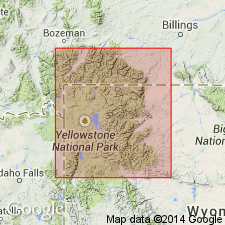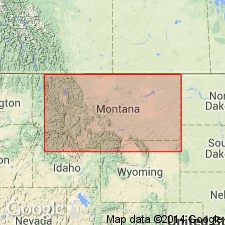
- Usage in publication:
-
- Absaroka Volcanic Supergroup*
- Modifications:
-
- Original reference
- Dominant lithology:
-
- Volcanics
- AAPG geologic province:
-
- Bighorn basin
- Montana folded belt
- Yellowstone province
Summary:
Absaroka Volcanic Supergroup. Divided into three groups (ascending): Washburn, Sunlight, and Thorofare Creek (all new). Consists largely of calc-alkalic andesite and dacite extrusive rocks, lesser amounts of potassic alkalic mafic lavas, and minor amounts of rhyodacitic ash-flow tuffs associated with mafic lavas. Thickness up to 5,000 feet. Age is early, middle, and possibly late Eocene (late Wasatchian, early Bridgerian, and possibly Uintan age of Wood and others, 1941, GSA Bull., v. 52, no. 1, p. 1-48), based on fossils and radiometric age determinations. (Absaroka Volcanic Supergroup and its subdivisions adopted by the USGS.)
Type area: Absaroka volcanic field and vicinity, in and around Yellowstone National Park, northwestern WY and southwestern MT. The Absaroka volcanic field is the largest of many volcanic fields formed in the Eocene. It covers about 9,000 sq. mi. The volume of rocks exceeds 7,000 cu. mi.
Source: Publication; US geologic names lexicon (USGS Bull. 1520, p. 5); Changes in stratigraphic nomenclature, 1972 (USGS Bull. 1394-A, p. A2-A3).

- Usage in publication:
-
- Absaroka Volcanic Supergroup*
- Modifications:
-
- Revised
- AAPG geologic province:
-
- Yellowstone province
Summary:
Absaroka Volcanic Supergroup. Includes middle Eocene Hominy Peak Formation (new), a sequence of mafic volcaniclastic sedimentary and igneous rocks as much as 2,000 feet (610 m) thick, exposed at north end and on west flank of Teton Range, as well as along south boundary of Yellowstone National Park, northwestern Wyoming.
Source: Publication.

- Usage in publication:
-
- Absaroka Volcanic Supergroup*
- Modifications:
-
- Geochronologic dating
Summary:
An unaltered sample from main phase of Independence stock yielded a 40Ar/39Ar (biotite) age of 48.8 +/-0.13 Ma. The Independence stock was emplaced as igneous activity in the Absaroka volcanic field culminated. This age is much younger than previously published Rb/Sr ages from the main phase and from a late stage granitic vein of 84 Ma.
Source: Modified from GNU records (USGS DDS-6; Denver GNULEX).
For more information, please contact Nancy Stamm, Geologic Names Committee Secretary.
Asterisk (*) indicates published by U.S. Geological Survey authors.
"No current usage" (†) implies that a name has been abandoned or has fallen into disuse. Former usage and, if known, replacement name given in parentheses ( ).
Slash (/) indicates name conflicts with nomenclatural guidelines (CSN, 1933; ACSN, 1961, 1970; NACSN, 1983, 2005, 2021). May be explained within brackets ([ ]).

